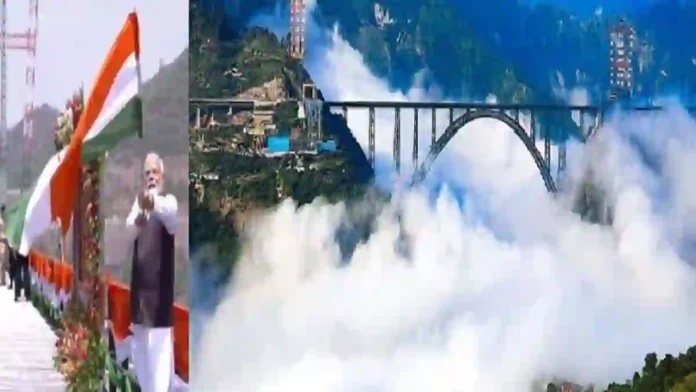After landing at the Air Force station in Udhampur, PM Modi flew to the Chenab bridge site to formally inaugurate the marvel. Prime Minister Narendra Modi on Friday inaugurated the Chenab railway bridge, the world’s highest rail bridge, marking a historic milestone in India’s infrastructure journey.
The bridge, a critical component of the Udhampur-Srinagar-Baramulla Railway Link (USBRL) project, was officially opened alongside the launch of Anji Khad bridge and the two Vande Bharat Express trains connecting Katra to Srinagar, ushering in all-weather rail connectivity between Kashmir and the rest of India.
The arch bridge, situated between Bakkal and Kauri in the Reasi district, creates a vital link between Katra and Banihal.
The 1,315-metre (m) Chenab bridge is a critical component of the Rs 35,000 crore Udhampur-Srinagar-Baramulla Rail Link (USBRL) project, which aims to improve connectivity in Jammu and Kashmir.
The Rs 14,000 crore Chenab Bridge stands 359 m (around 1,178 feet) over the Chenab River, making it 35 m taller than the Eiffel Tower in Paris, France.
The bridge is designed to withstand winds of up to 260 kilometres (km) per hour and is expected to have a shelf life of around 120 years. It has a 20.15 km-long approach road and is earthquake-resistant.
Notably, Indian Railways has implemented a comprehensive safety measure to minimise the potential impact of a bomb blast on the bridge.
A 780-m-long blast protection platform, a first in India’s rail sector, will feature on the bridge’s surface to absorb explosion impact during train operations.
The protection platform is positioned on both sides of the track on the bridge, comprising 165 steel decks, some measuring 17 m in length and the rest 13.5 m.
The bridge construction process involved excavating about 12 lakh cubic metres of earth.
Globally renowned tunnelling experts contributed to the tunnelling works in the section.
The sophisticated Tekla software was deployed for structural detailing using structural steel suitable for temperatures between -10 degrees Celsius and 40 degrees Celsius.
Read- India to produce Rafale, Dassault Aviation partners with Tata Advanced Systems
As part of the smart asset management system, 120 sensors are installed as part of the structural health monitoring system for the Chenab arch bridge.
These sensors operate round the clock and provide essential real-time data on various factors like wind velocity, temperature, humidity, and vibrations.
Constructing the Chenab Bridge in the rugged Himalayan terrain presented formidable challenges for the engineers.
The site, located in the Reasi district of Jammu and Kashmir, is perched above a deep gorge with steep, rocky slopes.
This topography made foundational work, equipment installation, and material transportation logistically demanding.
The elevation at which the bridge sits — 359 metres above the Chenab River — further complicated crane operations, worker safety, and on-site mobility.
The region’s seismic and climatic conditions further imposed severe engineering demands.
Situated in a high seismic zone (Zone IV), the bridge had to be designed to withstand earthquakes up to magnitude 8.0.
Further the climate in the region varies dramatically, from -10 degree celsius in winters to 40 degree celsius in summers.
This range demanded the use of special-grade steel and weather-resistant construction materials.
High-velocity winds and heavy snowfall further reduced the number of workable days in a year, prolonging the overall construction timeline.
Logistical hurdles were among the most significant operational constraints.
The remoteness of the site meant there was no pre-existing infrastructure.
Indian Railways and its contractors had to construct approach roads, set up electricity generation units, and transport even basic materials over long, winding mountain paths.
Labour mobilisation in such a terrain was another major challenge.
More than 1,300 workers and 300 engineers were deployed in phases, but their accommodation, safety, and transportation required creating dedicated access routes and camps in an otherwise inhospitable landscape.
Working at high altitudes and under unpredictable weather conditions posed constant risks, demanding rigorous safety protocols throughout the project lifecycle.
The construction of the bridge entailed the fabrication of 28,660 metric tonnes of steel, 10 lakh cubic metres of earthwork, 66,000 cubic metres of concrete, and the construction of 26 km of motorable roads.
However, after overcoming these hurdles, the bridge was successfully constructed and is now ready for public use.
For the people of Jammu and Kashmir, the bridge represents the culmination of a two-decade wait since its first approval in 2003.
Source- swarajyamag




